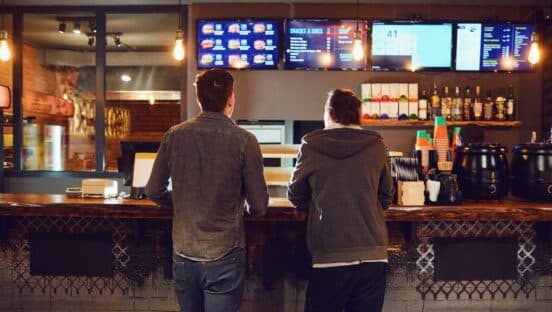





Beverages, specifically, coffee, have shown rapid growth within the quick-service restaurant industry. But what is the distinguishing factor behind this explosive growth? What can the quick-service restaurant industry learn from coffee brands leading the industry?
Three of the top 10 fastest-growing chains are coffee chains (sorted by those in the top 50 by systemwide sales). Some of the key ingredients to this success are revealed in a recent market study performed by Intouch Insight, which took a deep dive into coffee trends. The coffee study examined the performance of six leading coffee chains.
Good customer service is at the heart of the quick-service industry. But oftentimes it can be forgotten in favor of more easily measured metrics of success and customer satisfaction—like average ticket size.
Intouch Insight brings light to the numbers behind friendly customer service. Friendliness was 51 percent higher when the employee thanked the customer after their order was placed, and orders with friendly service were completed 59 seconds faster than those who did not receive friendly service.
Furthermore, accuracy was eight percent higher with friendlier service, and customer satisfaction was 16 percent higher when there was friendly service compared to when there was not. Friendly, good customer service impacts nearly every other metric of success in quick-service restaurants.
“It is a smile, it is saying ‘thank you’ and ‘my pleasure,’ and it’s not costing brands anything to be friendly,” says Laura Livers, chief revenue officer at Intouch Insight. While it does not cost anything to be friendly, it does cost restaurants if they are not friendly.
Regional brands, in particular, seem to be good at engaging customers in a friendly manner. Ninety-eight percent of the time regional brands say “thank you” compared to national brands which only say it 80 percent of the time. When looking at the impact of that disparity, it shows up in friendliness scores, which have an impact on loyalty. While regional brands scored 93 percent for friendliness, national brands scored 15 percent lower in friendliness.
Coffee is interesting in large part because any establishment can invest in a coffee or beverage program, and many have. What makes customers go out of their way to frequent one coffee brand over another is important, as it indicates what customers value in the quick-service industry.
Coffee brands that go the “extra mile” with customer service may have an edge in the market. Customer satisfaction overall is five percent higher when employees do something “extra,” like creating foam art, writing a name on the cup, or focusing on friendliness.
“Regional brands did something extra 53 percent of the time compared to the national brands 13 percent,” Livers says. “An extra could be writing your name on the cup right, knowing that you like a little extra foam, a little chocolate syrup, or extra pistachio squirt flavoring—something like that.”
Technology continues to drive customer satisfaction. Having a positive and friendly interaction is dependent on functional technology. Drive thrus continue to generate huge revenue for quick-service restaurants. Coffee chains in particular are known for the speed and accuracy of drive-thru ordering.
Friendliness linked to speed and accuracy is clear within this study. However, drive-thru friendliness is tied to clear communication through speakers and customers being clearly understood. Order accuracy and friendliness were 6 percent and 25 percent higher, respectively, when customers did not have to repeat themselves.
A quick-service restaurant needs to ensure that technology is easy to use for employees and customers so accuracy, satisfaction, and speed can be dependable at any location. Livers aptly says, “Regardless of whether it’s burgers, chicken, or coffee just say thank you with a smile.”
It is not often that quick-service restaurants receive a clear message on how exactly to succeed, but in this case, the data is clear. Friendliness, good customer service, and saying thank you every time are sure ways to improve metrics across the board. But, knowing if employees feel supported in taking these measures and are doing them needs to be measured to be understood at every establishment.
“How do you reward your employees?” asks Sarah Beckett, director of marketing at Intouch Insight. “Operators need to have mechanisms in place to measure it, to know what is being done, and then they can recognize and reinforce those good behaviors. So that’s where measurement tools—whether it’s mystery, shopping, or customer surveys—come into play to be able to understand whether employees are delivering on brand expectations.”
Identifying training gaps, smoothing out operations, and monitoring performance are all necessary to serve orders with a “thank you.” Operators and employees need to ensure that friendliness and positive customer interactions are still at the heart of everything restaurants do. Friendliness and politeness at the end of the day can be one of the best measures of how a restaurant is performing both front and back of the house.
Click here to learn more about how Intouch Insight can help measure and improve brands’ customer experiences.
Check out the full coffee market study from Intouch Insight here.
By Ya’el McLoud













